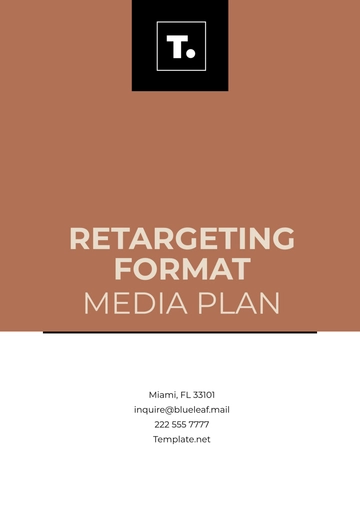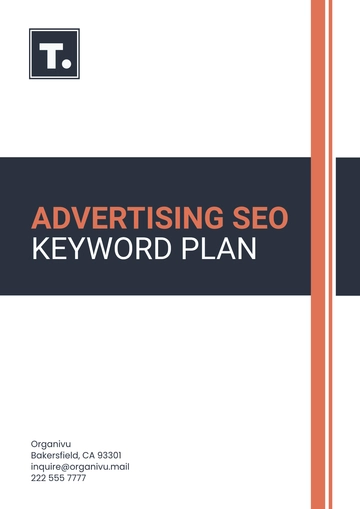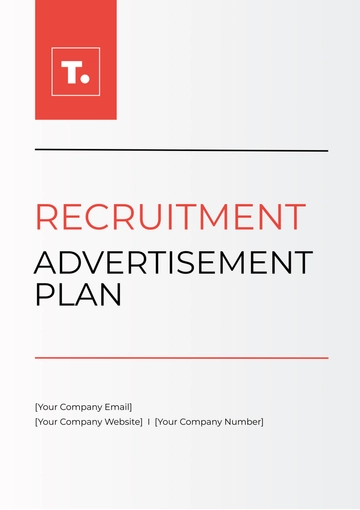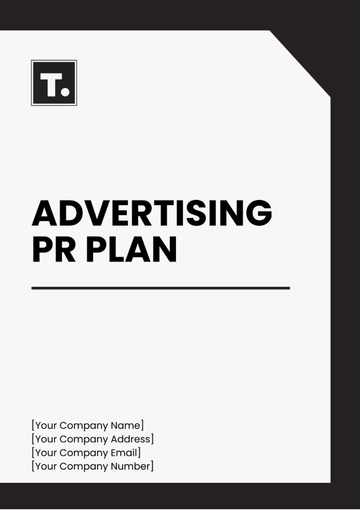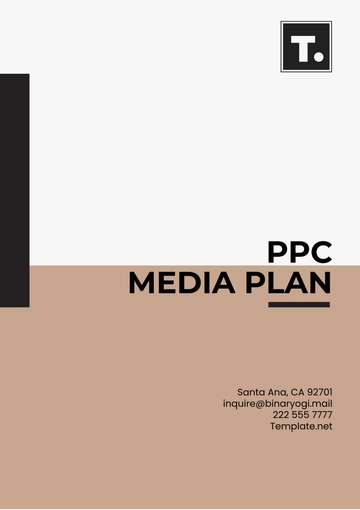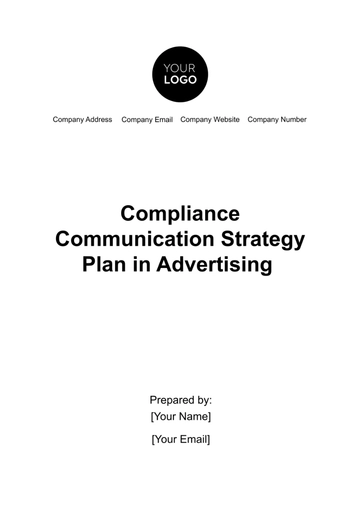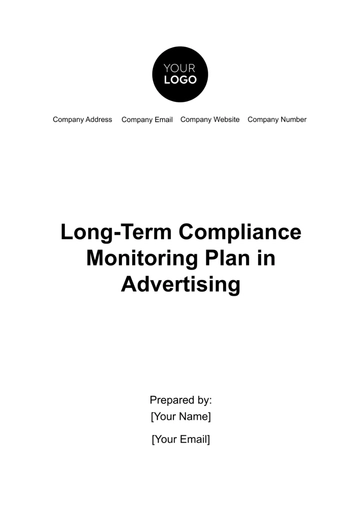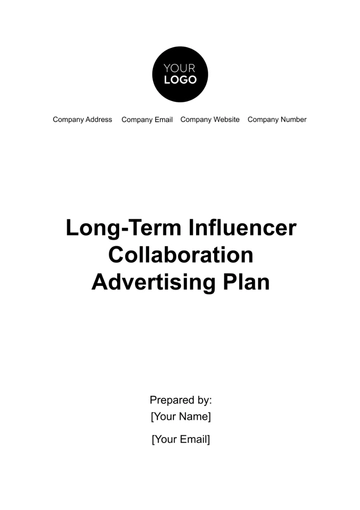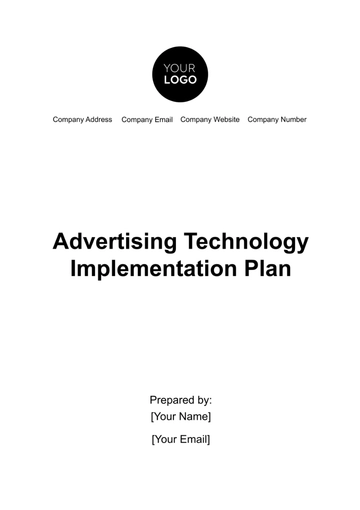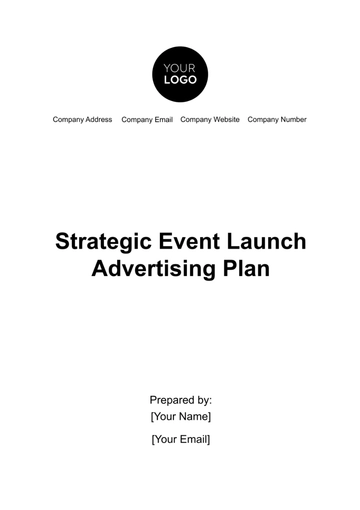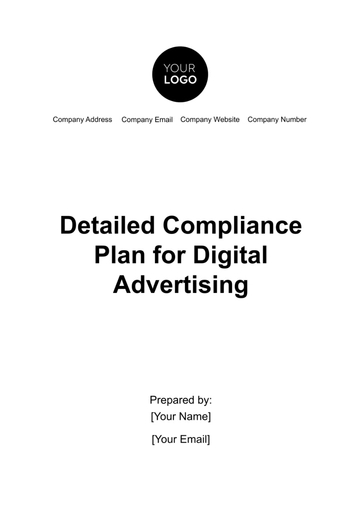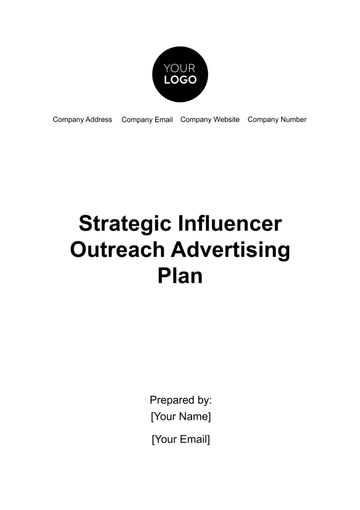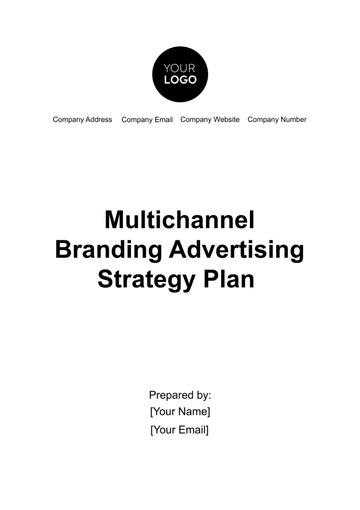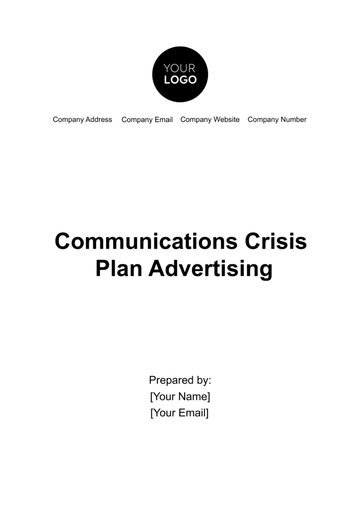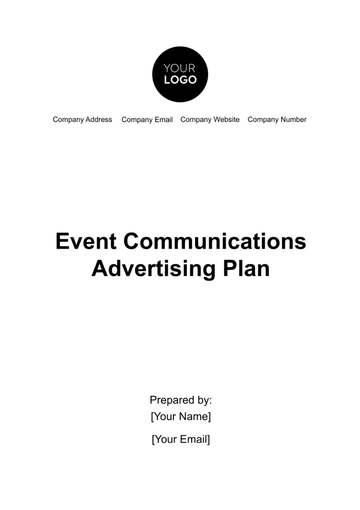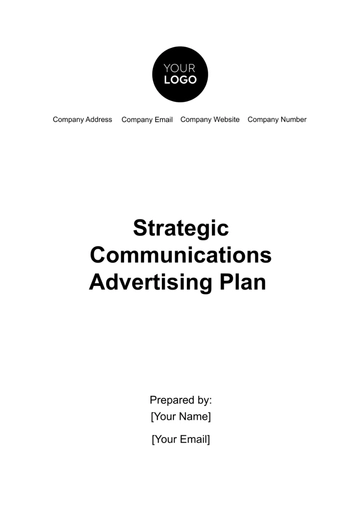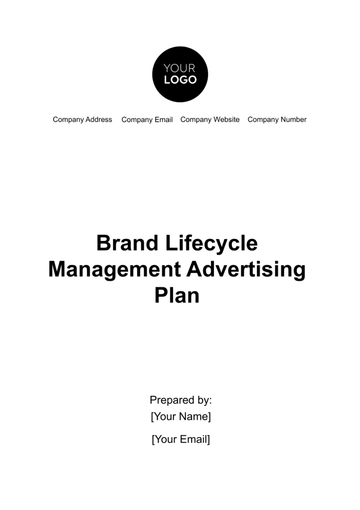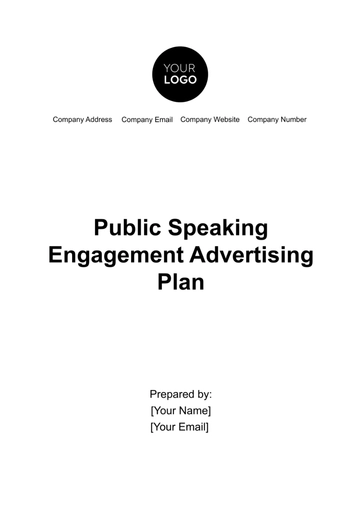Free Long-Term Compliance Monitoring Plan in Advertising
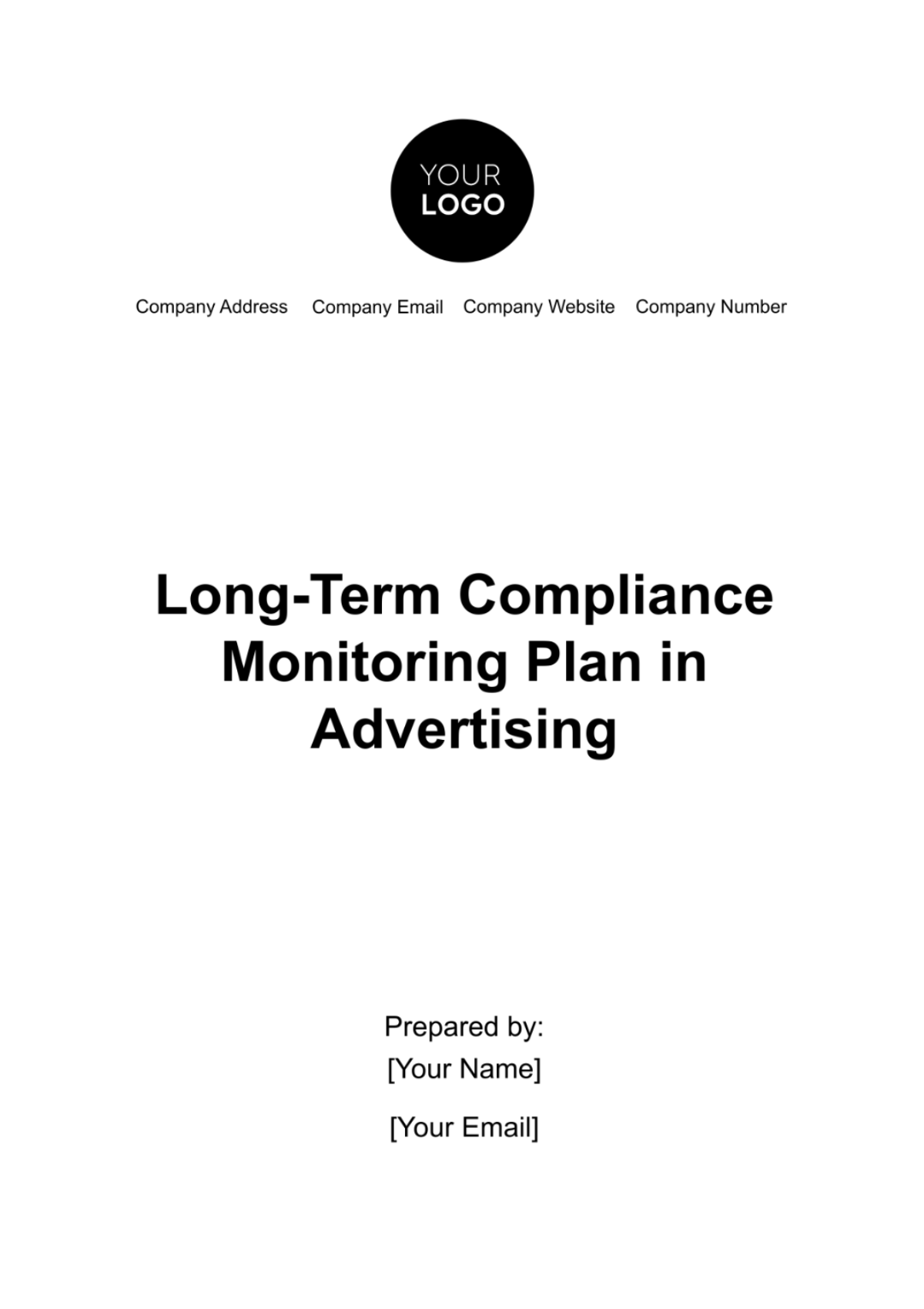
I. Introduction
This document serves as a guide for [Your Company Name] to ensure ongoing adherence to advertising compliance standards. It covers the management of compliance risks, adherence to legal advertising standards, and the promotion of ethical advertising practices. This plan is crucial in safeguarding the company’s reputation and avoiding legal pitfalls.
A. The plan applies to all forms of advertising, including digital, print, and broadcast media.
B. It covers compliance with laws such as the FTC's Truth in Advertising Standards, GDPR for data protection in advertising, and any industry-specific regulations.
C. The goal is to protect the company from legal risks, maintain consumer trust, and uphold the integrity of our advertising practices.
II. Compliance Objectives
This section defines the specific goals of the compliance plan. It focuses on maintaining the truthfulness of advertisements, avoiding deceptive practices, and ensuring that all advertising content is transparent and fair. This aligns the company’s advertising efforts with both legal requirements and ethical standards.
A. Objective 1: Ensure all advertising claims are truthful and substantiated.
B. Objective 2: Prevent any form of deceptive or misleading advertising practices.
C. Objective 3: Adhere to specific regulations related to advertising certain products or services.
III. Risk Assessment
Identifying and analyzing potential compliance risks in advertising activities is crucial. This section helps in evaluating the likelihood and impact of these risks, forming the basis for developing effective strategies to mitigate them.
A. Risk Identification
Identifying potential risks in advertising is crucial to developing a robust compliance monitoring plan. Risks can range from inadvertent errors to systematic issues within the advertising process. This section details the various types of risks that could arise and affect [Your Company Name]'s advertising compliance.
a. Misleading Claims:
Risks include exaggeration of product capabilities, false comparisons with competitors, or unverified endorsements.
b. Inadequate Disclosure:
Risks here involve failure to properly disclose sponsorships, partnerships, or terms and conditions associated with a product or promotion.
c. Non-Compliance with Specific Regulations:
This includes risks like not adhering to industry-specific advertising standards (e.g., for pharmaceuticals or financial services), violating data protection laws in digital advertising, or not following regional advertising laws for international campaigns.
d. Use of Prohibited Content:
Risk of including content that is offensive, discriminatory, or otherwise prohibited under advertising standards.
B. Risk Analysis
The potential impact of these risks on [Your Company Name] is multi-dimensional, affecting legal standing, brand reputation, and consumer trust. This section provides an analysis of how these risks, if realized, could impact the company.
a. Legal Penalties and Fines:
Non-compliance can lead to substantial fines and legal actions from regulatory bodies, resulting in significant financial loss and legal expenses.
b. Brand Reputation Damage:
Misleading or non-compliant advertising can lead to public backlash, loss of consumer confidence, and long-term damage to the brand’s reputation.
c. Consumer Trust Deterioration:
Inadequate disclosure or unethical advertising practices can erode consumer trust, leading to reduced customer loyalty and potential loss of market share.
d. Operational Disruptions:
Addressing non-compliance issues can divert resources from regular operations, leading to inefficiencies and potential loss of revenue.
IV. Compliance Standards and Procedures
This section details the specific compliance standards that the company’s advertising must adhere to, and outlines the procedures to ensure these standards are consistently met. It forms the core of the compliance plan, providing clear guidelines for advertising practices.
A. Standard 1: Review for Accuracy and Truthfulness
All advertising materials are subject to a thorough review to ensure their accuracy and truthfulness before public release.
a. Procedure: A collaborative review process involving both the legal and marketing teams is implemented to vet and approve all advertising content.
I. Substantiation of all health-related claims in wellness product advertisements.
II. Rigorous review of digital ads to ensure product efficacy claims are backed by scientific evidence.
B. Standard 2: Complete and Clear Disclosure in Advertising
Ensuring that all forms of sponsored content or partnerships are disclosed in a clear and comprehensible manner.
a. Procedure: Establish guidelines for content creators on how to effectively disclose sponsorships, following FTC guidelines.
I. Influencers must use clear and prominent [#ad or #sponsored] tags in promotional posts.
II. Explicit disclosure of terms and conditions in promotional offers and contests.
C. Standard 3: Compliance with Data Protection Laws
Strict adherence to data protection laws in digital advertising, particularly regarding consumer data usage and privacy.
a. Procedure: Regular audits of data collection and usage practices in digital advertising campaigns to ensure GDPR compliance.
I. Review and update privacy policies in online ads to ensure transparency in data usage.
II. Implement consumer consent protocols for targeted advertising.
D. Standard 4: Adherence to Industry-Specific Advertising Regulations
Compliance with regulations specific to the industry, such as pharmaceutical advertising rules or financial product advertising guidelines.
a. Procedure: Regular training sessions and updates for the marketing team on industry-specific regulations.
I. Pharmaceutical ads must include all necessary disclaimers and side-effect information.
II. Financial service ads must avoid misleading information regarding investment returns.
E. Standard 5: Prohibition of Offensive or Discriminatory Content
Ensuring that all advertising content is free from any offensive, discriminatory, or otherwise inappropriate material.
a. Procedure: Implementation of a content review checklist that specifically screens for sensitive or potentially harmful material.
I. Screening ad content for cultural sensitivity and inclusiveness.
II. Reviewing historical ads for any content that might be considered offensive in current contexts.
F. Standard 6: Ethical Representation of Products and Services
All products and services must be represented ethically, without overstatement or misrepresentation.
a. Procedure: A cross-functional team review, including product managers, to validate the authenticity of the product representations in advertisements.
I. Ensuring that visual representations of products in ads match the actual product.
II. Verifying that service capabilities are not exaggerated or misleading.
G. Standard 7: Monitoring and Regulation of Comparative Advertising
Ensuring that any comparative advertising is fair, factual, and not misleading. Comparative advertising must not disparage competitors unjustly or mislead consumers about the competitor's products.
a. Procedure: Establish a rigorous vetting process for all comparative advertising content. This process includes legal review to ensure fairness and accuracy, as well as a fact-checking procedure to confirm all claims made about competitors.
I. In a campaign comparing [Your Company Name]'s product with a competitor, each claim about the competitor’s product is fact-checked and substantiated with current market data.
II. Regular review and update of comparative ads to ensure that the information remains current and accurate, especially in fast-changing industries.
V. Monitoring Activities
Regular monitoring is essential to ensure ongoing compliance. This section outlines the schedule and methods for conducting compliance audits, focusing on specific areas that are prone to compliance risks.
A. Schedule: [Quarterly] audits to review all advertising materials and practices.
B. Methodology: Employ both internal audits and third-party compliance checks.
C. Areas to Monitor: Online ads, social media promotions, email marketing campaigns.
VI. Training and Education
Ongoing training and education for the marketing and advertising teams are vital. This section describes the plan for regular training programs and the resources needed to keep the team informed about compliance issues.
A. Develop a comprehensive training program covering all aspects of advertising compliance.
B. Regularly update training materials to reflect changes in laws and regulations.
C. Incorporate practical examples and case studies to illustrate compliance issues.
VII. Reporting and Documentation
Maintaining thorough documentation of compliance efforts and audit results is crucial for transparency. This section outlines the system for documenting compliance activities and the procedure for reporting any issues of non-compliance.
A. Implement a standardized system for recording all compliance checks and audit findings.
B. Establish a clear reporting channel for compliance issues.
C. Maintain records of corrective actions taken in response to compliance issues.
VIII. Response Plan for Non-Compliance
In cases where non-compliance is detected, having a clear response plan is necessary. This section outlines the immediate steps, disciplinary actions, and corrective measures to address any compliance breaches.
A. Outline immediate steps to rectify non-compliant advertisements.
B. Define disciplinary actions for responsible parties.
C. Implement corrective measures to prevent future instances of non-compliance.
IX. Review and Update Mechanism
The advertising landscape is constantly evolving, making regular reviews and updates to the compliance plan essential. This section describes the process for keeping the plan current with changes in laws, regulations, and industry practices.
A. Schedule annual reviews of the compliance plan.
B. Procedure for updating the plan in response to new regulations or industry changes.
C. Involve legal, marketing, and compliance teams in the review process.
Conclusion
This Long-Term Compliance Monitoring Plan is a testament to our dedication to integrity and truthfulness in all our marketing communications. By adhering to these guidelines, we ensure that every piece of advertising content we produce is not only effective but also aligns with the values we hold dear as a company. By rigorously applying these compliance standards, we not only protect ourselves from legal repercussions but also reinforce the trust our consumers place in us. We encourage all staff to embrace these principles, ensuring that [Your Company Name] continues to lead by example in ethical advertising.
- 100% Customizable, free editor
- Access 1 Million+ Templates, photo’s & graphics
- Download or share as a template
- Click and replace photos, graphics, text, backgrounds
- Resize, crop, AI write & more
- Access advanced editor
Empower your advertising compliance strategy with Template.net's Long-Term Compliance Monitoring Plan in Advertising Template. This editable and customizable tool, enhanced by our Ai Editor Tool, enables thorough monitoring and adjustment of compliance measures. Ensure sustained adherence to regulations and industry standards for long-term success in advertising endeavors.
You may also like
- Finance Plan
- Construction Plan
- Sales Plan
- Development Plan
- Career Plan
- Budget Plan
- HR Plan
- Education Plan
- Transition Plan
- Work Plan
- Training Plan
- Communication Plan
- Operation Plan
- Health And Safety Plan
- Strategy Plan
- Professional Development Plan
- Advertising Plan
- Risk Management Plan
- Restaurant Plan
- School Plan
- Nursing Home Patient Care Plan
- Nursing Care Plan
- Plan Event
- Startup Plan
- Social Media Plan
- Staffing Plan
- Annual Plan
- Content Plan
- Payment Plan
- Implementation Plan
- Hotel Plan
- Workout Plan
- Accounting Plan
- Campaign Plan
- Essay Plan
- 30 60 90 Day Plan
- Research Plan
- Recruitment Plan
- 90 Day Plan
- Quarterly Plan
- Emergency Plan
- 5 Year Plan
- Gym Plan
- Personal Plan
- IT and Software Plan
- Treatment Plan
- Real Estate Plan
- Law Firm Plan
- Healthcare Plan
- Improvement Plan
- Media Plan
- 5 Year Business Plan
- Learning Plan
- Marketing Campaign Plan
- Travel Agency Plan
- Cleaning Services Plan
- Interior Design Plan
- Performance Plan
- PR Plan
- Birth Plan
- Life Plan
- SEO Plan
- Disaster Recovery Plan
- Continuity Plan
- Launch Plan
- Legal Plan
- Behavior Plan
- Performance Improvement Plan
- Salon Plan
- Security Plan
- Security Management Plan
- Employee Development Plan
- Quality Plan
- Service Improvement Plan
- Growth Plan
- Incident Response Plan
- Basketball Plan
- Emergency Action Plan
- Product Launch Plan
- Spa Plan
- Employee Training Plan
- Data Analysis Plan
- Employee Action Plan
- Territory Plan
- Audit Plan
- Classroom Plan
- Activity Plan
- Parenting Plan
- Care Plan
- Project Execution Plan
- Exercise Plan
- Internship Plan
- Software Development Plan
- Continuous Improvement Plan
- Leave Plan
- 90 Day Sales Plan
- Advertising Agency Plan
- Employee Transition Plan
- Smart Action Plan
- Workplace Safety Plan
- Behavior Change Plan
- Contingency Plan
- Continuity of Operations Plan
- Health Plan
- Quality Control Plan
- Self Plan
- Sports Development Plan
- Change Management Plan
- Ecommerce Plan
- Personal Financial Plan
- Process Improvement Plan
- 30-60-90 Day Sales Plan
- Crisis Management Plan
- Engagement Plan
- Execution Plan
- Pandemic Plan
- Quality Assurance Plan
- Service Continuity Plan
- Agile Project Plan
- Fundraising Plan
- Job Transition Plan
- Asset Maintenance Plan
- Maintenance Plan
- Software Test Plan
- Staff Training and Development Plan
- 3 Year Plan
- Brand Activation Plan
- Release Plan
- Resource Plan
- Risk Mitigation Plan
- Teacher Plan
- 30 60 90 Day Plan for New Manager
- Food Safety Plan
- Food Truck Plan
- Hiring Plan
- Quality Management Plan
- Wellness Plan
- Behavior Intervention Plan
- Bonus Plan
- Investment Plan
- Maternity Leave Plan
- Pandemic Response Plan
- Succession Planning
- Coaching Plan
- Configuration Management Plan
- Remote Work Plan
- Self Care Plan
- Teaching Plan
- 100-Day Plan
- HACCP Plan
- Student Plan
- Sustainability Plan
- 30 60 90 Day Plan for Interview
- Access Plan
- Site Specific Safety Plan

